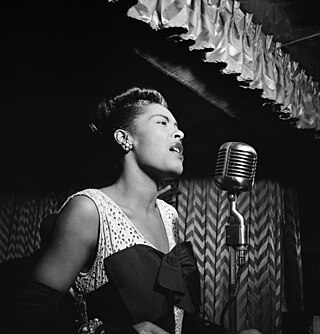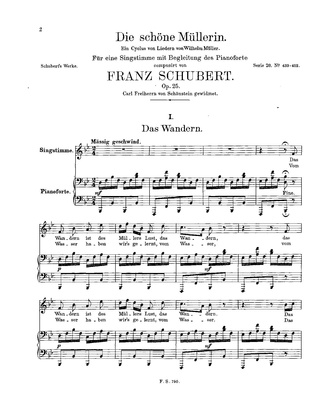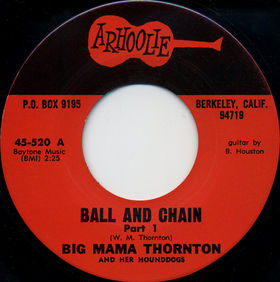Related Research Articles

Blues is a music genre and musical form that originated in the Deep South of the United States around the 1860s. Blues incorporated spirituals, work songs, field hollers, shouts, chants, and rhymed simple narrative ballads from the African-American culture. The blues form is ubiquitous in jazz, rhythm and blues, and rock and roll, and is characterized by the call-and-response pattern, the blues scale, and specific chord progressions, of which the twelve-bar blues is the most common. Blue notes, usually thirds, fifths or sevenths flattened in pitch, are also an essential part of the sound. Blues shuffles or walking bass reinforce the trance-like rhythm and form a repetitive effect known as the groove.

A ballad is a form of verse, often a narrative set to music. Ballads derive from the medieval French chanson balladée or ballade, which were originally "dance songs". Ballads were particularly characteristic of the popular poetry and song of Britain and Ireland from the Late Middle Ages until the 19th century. They were widely used across Europe, and later in Australia, North Africa, North America and South America.

Janis Lyn Joplin was an American singer and songwriter. One of the most successful and widely known rock performers of her era, she was noted for her powerful mezzo-soprano vocals, as well as her "electric" stage presence.
Pop music is a type of popular music that originated in its modern form during the mid-1950s in the United States and the United Kingdom. During the 1950s and 1960s, pop music encompassed rock and roll and the youth-oriented styles it influenced. Rock and pop music remained roughly synonymous until the late 1960s, after which pop became associated with music that was more commercial, ephemeral, and accessible.
Rock is a broad genre of popular music that originated as "rock and roll" in the United States in the late 1940s and early 1950s, developing into a range of different styles from the mid-1960s, particularly in the United States and the United Kingdom. It has its roots in 1940s and 1950s rock and roll, a style that drew directly from the blues and rhythm and blues genres of African-American music and from country music. Rock also drew strongly from genres such as electric blues and folk, and incorporated influences from jazz and other musical styles. For instrumentation, rock has centered on the electric guitar, usually as part of a rock group with electric bass guitar, drums, and one or more singers. Usually, rock is song-based music with a 4
4 time signature using a verse–chorus form, but the genre has become extremely diverse. Like pop music, lyrics often stress romantic love but also address a wide variety of other themes that are frequently social or political. Rock was the most popular genre of music in the U.S. and much of the Western world from the 1950s to the 2010s.
Ragtime, also spelled rag-time or rag time, is a musical style that had its peak from the 1890s to 1910s. Its cardinal trait is its syncopated or "ragged" rhythm. Ragtime was popularized during the early 20th century by composers such as Scott Joplin, James Scott and Joseph Lamb. Ragtime pieces are typically composed for and performed on piano, though the genre has been adapted for a variety of instruments and styles.

A song is a musical composition performed by the human voice. This is often done at distinct and fixed pitches (melodies) using patterns of sound and silence. Songs contain various forms, such as those including the repetition and variation of sections.

A refrain is the line or lines that are repeated in music or in poetry — the "chorus" of a song. Poetic fixed forms that feature refrains include the villanelle, the virelay, and the sestina.
In music, form refers to the structure of a musical composition or performance. In his book, Worlds of Music, Jeff Todd Titon suggests that a number of organizational elements may determine the formal structure of a piece of music, such as "the arrangement of musical units of rhythm, melody, and/or harmony that show repetition or variation, the arrangement of the instruments, or the way a symphonic piece is orchestrated", among other factors. It is, "the ways in which a composition is shaped to create a meaningful musical experience for the listener."
"Form refers to the largest shape of the composition. Form in music is the result of the interaction of the four structural elements described above [sound, harmony, melody, rhythm]."
A work song is a piece of music closely connected to a form of work, either one sung while conducting a task or one linked to a task that may be a connected narrative, description, or protest song. An example is "I've Been Working on the Railroad".

Strophic form – also called verse-repeating form, chorus form, AAA song form, or one-part song form – is a song structure in which all verses or stanzas of the text are sung to the same music. Contrasting song forms include through-composed, with new music written for every stanza, and ternary form, with a contrasting central section.
Industrial folk music, industrial folk song, industrial work song or working song is a subgenre of folk or traditional music that developed from the 18th century, particularly in Britain and North America, with songs dealing with the lives and experiences of industrial workers. The origins of industrial folk song are in the British industrial revolution of the eighteenth century as workers tended to take the forms of music with which they were familiar, including ballads and agricultural work songs, and adapt them to their new experiences and circumstances. They also developed in France and the US as these countries began to industrialise.

The 32-bar form, also known as the AABA song form, American popular song form and the ballad form, is a song structure commonly found in Tin Pan Alley songs and other American popular music, especially in the first half of the 20th century.
Song structure is the arrangement of a song, and is a part of the songwriting process. It is typically sectional, which uses repeating forms in songs. Common forms include bar form, 32-bar form, verse–chorus form, ternary form, strophic form, and the 12-bar blues. Popular music songs traditionally use the same music for each verse or stanza of lyrics. Pop and traditional forms can be used even with songs that have structural differences in melodies. The most common format in modern popular music is introduction (intro), verse, pre-chorus, chorus, verse, pre-chorus, chorus, bridge, and chorus. In rock music styles, notably heavy metal music, there is usually one or more guitar solos in the song, often found after the middle chorus part. In pop music, there may be a guitar solo, or a solo performed with another instrument such as a synthesizer or a saxophone.
"What Good Can Drinkin' Do" is a blues song by Janis Joplin, considered the first song she ever recorded.

"Ball and Chain" is a blues song written and recorded by American blues artist Big Mama Thornton. Although her recording did not appear on the record charts, the song has become one of Thornton's best-known, largely due to performances and recordings by Janis Joplin.
Popular music is music with wide appeal that is typically distributed to large audiences through the music industry. These forms and styles can be enjoyed and performed by people with little or no musical training. It stands in contrast to both art music and traditional or "folk" music. Art music was historically disseminated through the performances of written music, although since the beginning of the recording industry, it is also disseminated through recordings. Traditional music forms such as early blues songs or hymns were passed along orally, or to smaller, local audiences.
A sentimental ballad is an emotional style of music that often deals with romantic and intimate relationships, and to a lesser extent, loneliness, death, war, drug abuse, politics and religion, usually in a poignant but solemn manner. Ballads are generally melodic enough to get the listener's attention.
Korean ballad, also known as K-ballad, is a style of music in South Korea and a genre in which soul and rhythm and blues music is transformed to suit Korean sentiment. It became popular in the 1980s, and has influenced and evolved into many different music styles.
Pop music is a genre of popular music that originated in its modern form during the mid-1950s in the United States and the United Kingdom. The terms popular music and pop music are often used interchangeably, although the former describes all music that is popular and includes many disparate styles. During the 1950s and 1960s, pop music encompassed rock and roll and the youth-oriented styles it influenced. Rock and pop music remained roughly synonymous until the late 1960s, after which pop became associated with music that was more commercial, ephemeral, and accessible.
References
- 1 2 T. A. Green, Folklore: An Encyclopedia of Beliefs, Customs, Tales, Music, and Art (ABC-CLIO, 1997), p. 81, ISBN 978-1-59884-241-8
- ↑ Boyd, Jack (1991). Encore!: A Guide to Enjoying Music, p. 31, ISBN 978-0-87484-862-5. "[32-bar form] is sometimes called ballad form because so many of our popular ballads, middle-of-the-road popular songs, and Country Western songs use this form."
- 1 2 3 N. Cohen, Folk Music: a Regional Exploration (Greenwood, 2005), pp. 14-29, ISBN 9780313328725
- ↑ R. DeV Renwick, Recentering Anglo/American Folksong: Sea Crabs and Wicked Youths (University Press of Mississippi, 2009), pp. 25-6, ISBN 9781604732542
- 1 2 D. M. Randel, The Harvard Dictionary of Music (Harvard University Press, 4th edn., 2003), p. 73, ISBN 978-0674011632
- ↑ R. Kostelanetz and J. Reiswig, The B.B. King Reader: 6 Decades of Commentary (Hal Leonard Corporation, 2nd edn., 2005), p. 287, ISBN 9780634099274
- ↑ R. Coleman, "Blue Monday: Fats Domino and the Lost Dawn of Rock 'n' Roll (Da Capo Press, 2007), p. 63, ISBN 978-0306815317
- ↑ "Janis Joplin: Biography". Archived from the original on 2016-12-16. Retrieved 2017-04-05.
- ↑ Whitburn, Joel (2004). The Billboard Book Of Top 40 Country Hits: 1944-2006, Second edition. Record Research. p. 131. ISBN 978-0823082896.